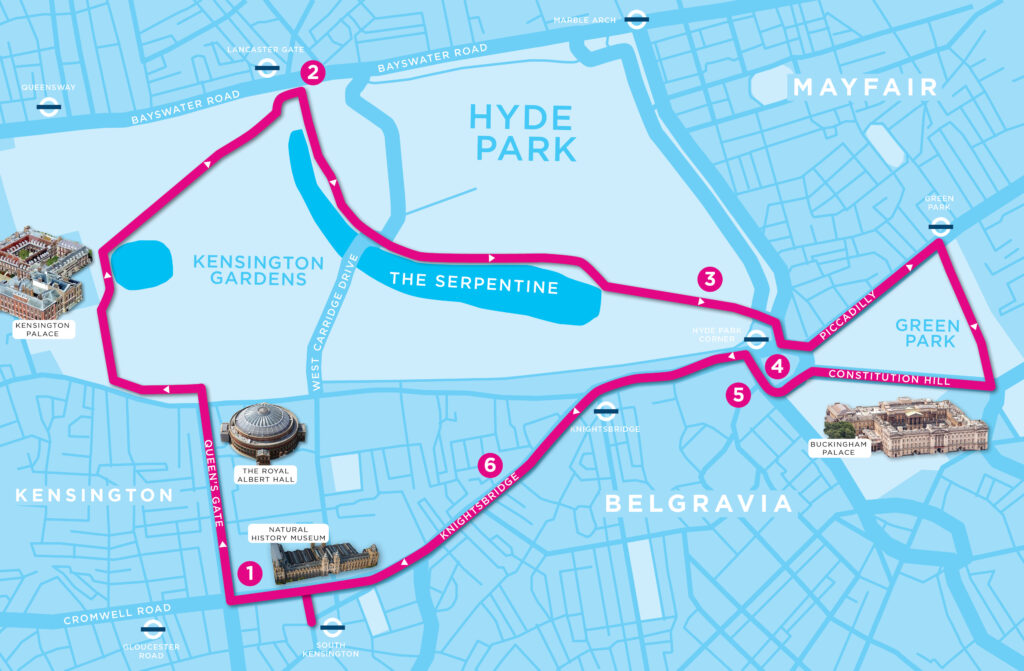Awesome Walking Route Ideas
Nowhere in London is more alive with rich, quintessentially British history and culture than Westminster. From the iconic and now squeaky clean Big Ben to the twisted, gothic beauty of Westminster Abbey, it is difficult to match the grandeur of this London borough to any other. It seems that down every hushed, haunted side street; behind every proud gateway; in every nook, cranny and historic stairwell, there are relics of London’s fascinating past to uncover.
So, to help you get the most out of the challenge, we’ve put together this handy walking guide series to help you clock up kilometres and maybe even learn something new about the glittering London jewel of Westminster.
ROUTE 1: ST JAMES’ PARK WITH SECRET LOCAL HISTORY
Start: St James’ Park Underground Station
Estimated route length (3 options available):
- 3. 63 miles (out and back through the park)
- 2. 44 miles back to the underground station
- 2.09 miles ending in Dean’s Yard
End: St James’ park
Route instructions with local sightseeing
Start at St James’ Park underground station, heading directly across the roundabout on the main road, up to Queen Ann’s Gate.
Take a right to Queen Ann’s Gate on the same road, to you can see the namesake of the road: a statue of the shy but assertive daughter Queen of the executed Charles ll. Continue walking, taking in the beautiful houses and authentic gas lamps will make you feel like you’re in a Charles Dicken’s novel (ghosts included, when they occasionally flicker and malfunction!) At the end of the road, turn left to see the Cockpit Steps where, yes, they used to hold cock-fights as a form of entertainment. Cut through this hidden alleyway to emerge onto Birdcage Walk.
Following the animal theme, Birdcage Walk is a famous road which used to be the location of the early 17th century King James I’s aviary. Bear left on this road, to eventually enter St James’ Park at the furthest entrance on the corner of the park. We recommend then walking around the lake, unless you fancy a slightly longer walk around the edges of the park. Fun facts about park are that James’ I first used it to house elephants and other exotic creatures. Later, when Charles II was on the throne, it had pelicans which were a gift from the Russian ambassador (they still have them today!) and the monarch was said to swim in the lake.
Walk around the lake, around Duck Island cottage, where on the left-hand side you can pop into Churchill’s War Rooms to see relics from the WW2 prime minister’s life (including, we’ve heard, his pyjamas!)
Exit once again onto Birdcage Walk and head down Storey’s Gate, across the main road, on the left-hand side. Take the second left to see the Methodist central hall, which held the first United Nations General Assembly in 1946, regular Suffragette meetings in 1914, and where the World Cup was housed when England held (and won) the event in 1966 (it was actually stolen and found a week later in a local park by a dog called Pickles…crazy right?!) Walk around the building, and then follow the main road out onto Broad Sanctuary.
Now, if you fancy it, you can take a few minutes to continue down this road and take the first left to Little Sanctuary road. Here, you can see the remains of Tothill prison, which saw countless criminals pass beneath it’s still-standing gate until it was closed in 1884. Otherwise, turn left down The Sanctuary (road) and snake your way down to Dean’s Yard, a former monastery which is now a boarding school. If you’re lucky, you’ll be able to walk through the yard – the perfect way to end your Westminster walk!

- Start – St James’ Park Underground Station.
- Queen Ann’s Gate. Although shy, Queen Ann could be prone to petulant moods. Visit the church in Smith Square which is nicknamed ‘Queen Ann’s Footstool’ and ask a local the secret to the name.
- Cockpit Steps. This particular cockpit was often frequented by aristocracy, earning it a reputation as a ‘royal’ cockpit.
- St James’ Park. It’s likely that the pelicans in the park today are ancestors of those which the Russian Ambassador gave to Charles I as a gift!)
- Churchill’s Museum and The Cabinet War Rooms. The Cabinet War Rooms are home to a surviving Enigma coding machine. Alan Turing broke the code to decipher German messages in 1941.
- Methodist Central Hall. Early Suffragette meetings were held here in 1914 and the venue has continued to host meetings for other movements seeking women’s rights and equality.
- Tothill Prison. The road that this prison was located on, Little Sanctuary, is so called because medieval criminals used to be able to seek sanctuary there.
- Dean’s Yard. The yard is part of a former monastery which is now a boarding school. The Westminster School Pupils have legal rights to play football on the green!
ROUTE 2: LONDON RIVER WALK AND COVENT GARDEN
Start: Westminster Station
Estimated route length: 3 miles
End: Westminster Station
Route instructions
Exit Westminster Station, observing Big Ben, and walk towards Westminster Bridge. Cross the bridge, sticking to the left-hand side , and take the first set of stairs on the left. This will lead you down to ‘The Queen’s Walk’ on the Southbank.
Walk down the Southbank towards The London Eye and the Jubilee Park & Garden. If you’re lucky, you will get to see some street performers or artists.
Continue walking, past the Hungerford Bridge, until you get to Waterloo Bridge. Take the stairs up and cross, sticking to the right-hand side of the pavement. At the end of the bridge, keep waking and you will reach a junction on the Strand. Take a left, then a right onto Burleigh Street; follow this road to the London Transport Museum, and emerge into Covent Garden down one of the through roads.
Begin to make an anti-clockwise loop, past the London Transport Museum and tables on the cobblestones. Always take a left, heading in the direction of the station, until you get to St James Street where you should take a right. Once at the station, turn left onto London Acre Street and weave right onto the narrow but picturesque Mercer Street, a few paces along. Walk the whole length of Mercer Street until you reach the Seven Dials.
Take the Earlham Street ‘dial’ and exit onto Shaftesbury Avenue. You’re on the home stretch now: bear left and left again so that you are on Charing Cross road, and follow this main road all the way to Trafalgar Square. Here, at the statue of Charles I, you need to follow Whitehall (2nd exit at the roundabout), which will take you back to your starting place near Big Ben.

- Big Ben. Many people think that Big Ben’s recent makeover in blue paint is new, but this is actually false. When it last received a new lick of paint, the original blue of Charles Barry and A.W. Pugin’s design was painted over in black. This was because the air was so polluted that it had turned this colour, so the renovators just stuck with it.
- The London Eye. The London Eye has 32 capsules which are said to represent the 32 London Boroughs. However, as with many large-scale attractions, there is no ‘unlucky’ number 13th capsule – rather, it is skipped and the numbers go to 33.
- Waterloo Bridge (image with text): Most people know Waterloo Bridge is nicknamed the Ladies’ Bridge because it was built by a largely female workforce during the war. The women’s work is now officially acknowledged: there are plans to erect a plaque to this effect.
- The British Transport Museum. This building used to be the site of the Victorian Flower Market Building in Covent Garden’s world-famous Piazza. This was next to the Apple Market, selling fruit and vegetables, where in 1650 began selling pineapples. The tangy fruit was so popular with customers that it became the symbol of Covent Gardens and if you look carefully, you can see it in architecture in other London locations…
- The Seven Dials. The Seven Dials was originally laid out by Thomas Neale, MP in the early 1690s, who cleverly laid out the area in a series of triangles to maximise the number of houses as rentals were charged per foot of frontage and not per square foot of interiors.
- Trafalgar Square. Think you’ve been everything in Trafalgar Square? What about the smallest police box in London? That’s right; built in 1926, this compact space allowed police officers to keep a low profile, especially when watching over large protests and gatherings in the square. See if you can spot in as you pass through (hint: it’s not Tardis-blue unfortunately!)
ROUTE 3: PARK TO PARK WITH SOUTH KENSINGTON
Start: Knightsbridge Station
Estimated route length: 5.82 miles
End: Knightsbridge Station
Exit South Kensington and bear left onto Harrington Road. Once you reach the junction, a short way up, turn right onto Queen’s Gate. Look out for the Natural History museum on your right side – you can’t miss it! Continue up the road and you will also pass the prestigious Imperial College London, where the rock legends Queen began life (look it up for yourself).
At the top of Queen’s Gate turn left onto the main road, follow the road down and then take the first right onto Broad Walk in Hyde Park, a wide, gently undulating path which captures the peaceful pleasure of the park. Walk up Broad Walk until you get to the Round Pond, where you want to bear right, ideally so that you join Budge’s Walk. You are now heading towards the Italian Gardens which is a beautiful place to grab a coffee.
Turn left at the Gardens so that you are hugging the Serpentine and continue walking. You will need to go around the Serpentine North Art Gallery. Continue on this same path all the way past the lake, until you are heading towards the Hyde Park Corner Underground Station exit. Take this exit and cross the road so that you cut through Wellington Arch (this area can get busy but you can’t miss the arch!) Cross the road again and bear left so that you hop over to Green Park.
Next, complete one lap of Green Park, sticking to the outside of the park to make the whole route distance, and you will eventually come back to Wellington Arch once more. Cut through again and take the first exit onto Knightbridge Road – yes, that’s right, we’re going to explore one of London’s most luxurious neighbourhoods! However, if you associate Knightsbridge solely with Harrods, its time to get to known this area a little better. Although you can walk down the main road, passing by high-end shops, restaurants and yes, the world-famous department store Harrods, we recommend dipping into the space between Brompton Road and Hyde park, where you will enter a beautiful labyrinth of houses and architecture. Simply take a right off Brompton Road into Lancelot Place, where you can wander around streets and squares such as Trevor Square and Brompton Square, always bearing left until you gradually work your way back to Knightsbridge station where this walk ends.


